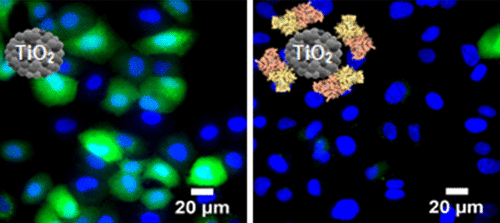当前位置:
X-MOL 学术
›
Bioconjugate Chem.
›
论文详情
Our official English website, www.x-mol.net, welcomes your
feedback! (Note: you will need to create a separate account there.)
Intracellular Generation of Superoxide by TiO2 Nanoparticles Decreases Histone Deacetylase 9 (HDAC9), an Epigenetic Modifier.
Bioconjugate Chemistry ( IF 4.0 ) Pub Date : 2020-04-08 , DOI: 10.1021/acs.bioconjchem.0c00091 Dhanya T Jayaram 1 , Christine K Payne 1
Bioconjugate Chemistry ( IF 4.0 ) Pub Date : 2020-04-08 , DOI: 10.1021/acs.bioconjchem.0c00091 Dhanya T Jayaram 1 , Christine K Payne 1
Affiliation

|
Titanium dioxide (TiO2) nanoparticles are used on a massive scale in commercial and industrial products. Of specific concern is how the inhalation of these nanoparticles in a manufacturing setting may affect human health. We examine the cellular response to TiO2 nanoparticles using a combination of cell-free spectroscopic assays, fluorescence microscopy, Western blotting, and TiO2 nanoparticle surface modifications. These experiments show that TiO2 nanoparticles generate superoxide, both in solution and in cells, and this intracellular superoxide decreases expression of histone deacetylase 9 (HDAC9), an epigenetic modifier. We use protein coronas formed from superoxide dismutase (SOD) and catalase, enzymes that scavenge reactive oxygen species (ROS), to probe the relationship between TiO2 nanoparticles, ROS, and the subsequent cellular response. These protein coronas provide nanoparticle-localized scavengers that demonstrate that the nanoparticles are the source of the intracellular superoxide. Importantly, the use of a SOD corona or surface passivated TiO2 nanoparticles prevents the decrease of HDAC9. These experiments elucidate the underlying mechanism of TiO2 nanoparticle-mediated cellular responses including oxidative stress and changes in gene expression. They also provide the first demonstration of a protein corona as a tool for probing cellular responses to nanoparticles. Overall, this research shows that low, nontoxic concentrations of TiO2 nanoparticles alter an enzyme responsible for epigenetic modifications, which points to concerns regarding long-term exposures in manufacturing settings.
中文翻译:

TiO2纳米粒子在细胞内产生超氧化物会降低组蛋白脱乙酰基酶9(HDAC9),一种表观遗传修饰剂。
二氧化钛(TiO2)纳米颗粒已在商业和工业产品中大规模使用。特别令人关注的是,在制造环境中吸入这些纳米颗粒如何影响人类健康。我们使用无细胞光谱测定,荧光显微镜,蛋白质印迹和TiO2纳米颗粒表面修饰的组合来检查细胞对TiO2纳米颗粒的反应。这些实验表明,TiO2纳米颗粒在溶液和细胞中都会产生超氧化物,并且这种细胞内超氧化物会降低组蛋白脱乙酰基酶9(HDAC9)(一种表观遗传修饰剂)的表达。我们使用由超氧化物歧化酶(SOD)和过氧化氢酶(清除活性氧(ROS)的酶)形成的蛋白质电晕来探查TiO2纳米颗粒,ROS与后续细胞反应之间的关系。这些蛋白质电晕提供了纳米粒子定位的清除剂,这些清除剂表明纳米粒子是细胞内超氧化物的来源。重要的是,使用SOD电晕或表面钝化的TiO2纳米颗粒可防止HDAC9的减少。这些实验阐明了TiO2纳米粒子介导的细胞反应的潜在机制,包括氧化应激和基因表达的变化。他们还首次展示了蛋白质电晕作为探测细胞对纳米粒子反应的工具。总体而言,这项研究表明,低浓度,无毒的TiO2纳米颗粒会改变负责表观遗传修饰的酶,这引起了人们对制造环境中长期暴露的担忧。
更新日期:2020-03-29
中文翻译:

TiO2纳米粒子在细胞内产生超氧化物会降低组蛋白脱乙酰基酶9(HDAC9),一种表观遗传修饰剂。
二氧化钛(TiO2)纳米颗粒已在商业和工业产品中大规模使用。特别令人关注的是,在制造环境中吸入这些纳米颗粒如何影响人类健康。我们使用无细胞光谱测定,荧光显微镜,蛋白质印迹和TiO2纳米颗粒表面修饰的组合来检查细胞对TiO2纳米颗粒的反应。这些实验表明,TiO2纳米颗粒在溶液和细胞中都会产生超氧化物,并且这种细胞内超氧化物会降低组蛋白脱乙酰基酶9(HDAC9)(一种表观遗传修饰剂)的表达。我们使用由超氧化物歧化酶(SOD)和过氧化氢酶(清除活性氧(ROS)的酶)形成的蛋白质电晕来探查TiO2纳米颗粒,ROS与后续细胞反应之间的关系。这些蛋白质电晕提供了纳米粒子定位的清除剂,这些清除剂表明纳米粒子是细胞内超氧化物的来源。重要的是,使用SOD电晕或表面钝化的TiO2纳米颗粒可防止HDAC9的减少。这些实验阐明了TiO2纳米粒子介导的细胞反应的潜在机制,包括氧化应激和基因表达的变化。他们还首次展示了蛋白质电晕作为探测细胞对纳米粒子反应的工具。总体而言,这项研究表明,低浓度,无毒的TiO2纳米颗粒会改变负责表观遗传修饰的酶,这引起了人们对制造环境中长期暴露的担忧。











































 京公网安备 11010802027423号
京公网安备 11010802027423号